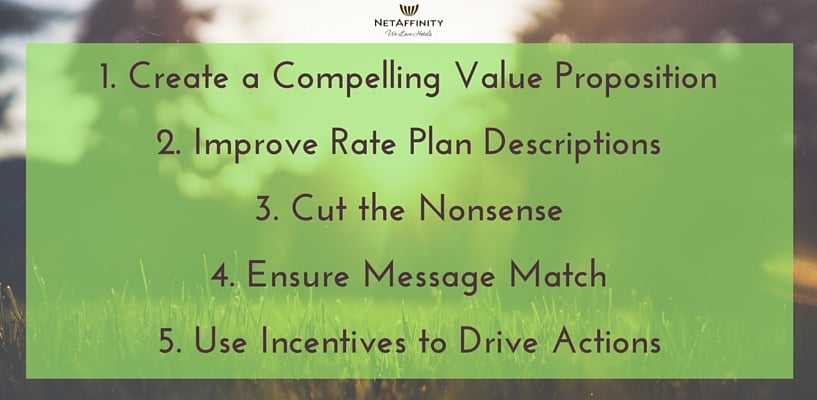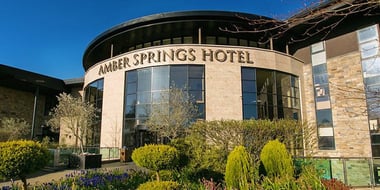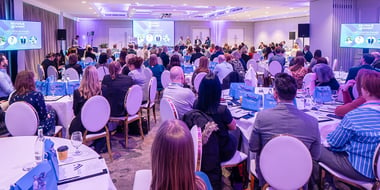As a hotelier, your goal is to sell rooms. You want people to book your special offers, and you want a lot of people to book. There are a lot of new techniques and fancy tools out there to help you do that, especially as data and personalisation become more important. However, sometimes the quickest way to get more direct bookings is a bit of old-fashioned marketing.
Before you turn your focus to complicated techniques, use these 5 tips to improve the conversions for your special offers right now – before they leave!
Your hotel is probably spending a big part of its marketing budget to drive quality traffic to your own site, in a bid to convert direct bookings and reduce OTA commissions. That’s great! However, to get the best results, your special offers need to be as compelling as possible. Now is the time act to improve your special offer conversions.
Here’s 5 quick tips you can use right away:
1. Create a Compelling Value Proposition
Outline exactly what the value proposition of your special offer is. What is unique about your offer compared to your competitors? The offer description should show information about the offer and highlight its top features and USPs. It isn’t about selling the whole hotel – that’s what the rest of the site is for!
Avoid long paragraphs! Ensure the key details are at the beginning, and use bullet points to highlight the most important information.
Try to remove any concerns the booker may have about booking right away – if they start shopping around on third-party sites, the odds of them booking direct take a steep dive. If you have a ‘Best Rate Guarantee’ or offer ‘No Booking Fee,’ make sure to emphasize that in the rate plan description.
2. Improve Rate Plan Descriptions
Many hotel marketers try to improve conversion by changing font colours, styles etc. That’s great, but make sure your changes are consistent across rate plans. Keep the fonts style, size & colour consistent throughout all of your available rate plans. Avoid using titles which are all uppercase for some rate plans but not for others, for example.
You should:
- Keep it short and sweet!
- Make sure you highlight the value proposition at the beginning.
- Keep the tone of the text the same for all descriptions of the rate plans.
- If you have two similar rate plans, make it easy for the customer to differentiate – use different titles and make sure the two are distinct on the site.
Finally, update the messaging on your site regularly to ensure that it’s seasonally appropriate. If customers feel like the site content is outdated or not in tune with the season, they are more likely to get confused and leave – meaning you miss out on a conversion.
In line with that, take a look at your booking lead times. Don’t just think about now, be sure to think ahead and ensure you have your seasonal offers setup in advance! Putting up an offer a week in advance won’t get you the kind of results that setting it up to match your booking lead times will.
3. Cut the Nonsense
Try avoid ‘quirky’ rate plan names. Make it clear exactly what is included in the offer. This ‘quirky’ name might mean something to you, but will your customer understand it straight away? Don’t make it difficult for the customer to know what the package is about! They don’t want to read two paragraphs to find out if it includes breakfast.
Be clear and precise – If dinner is included, give guests a few specifics to set the scene. Is this dinner in the bar or restaurant? How many courses are included?
Avoid industry jargon. Most of your customers won’t understand terms such as ‘BB’ or ‘1DBB,’ so don’t drive them to Google or away from your site entirely by using those terms.
Having a powerful headline is essential to gain attention, but clarity and value come first. If your headline has those, you’ll encourage that conversion.
4. Ensure Message Match
Oli Gardner, co-founder at Unbounce, defines message match as:
“A measure of how well your landing page copy matches the phrasing of the ad or link that brought the visitor there. For PPC marketers, this means matching your ad copy to your landing page headline. Strong message match increases conversions because it reassures people they’ve come to the right place.”
Make sure you’ve got message match between any marketing materials that got your customer to your offer page and the offer page itself. The images in your email should match the images on your landing page; the title of your rate plan should be the same as the words on your ads. Message match increases the chances that your visitors will make a booking on your site.
Ensure the title, image, offer name, description, price and price display are the same in your advertisements and on your offer page. For example, if your offer is being marketed at €99 per person, ensure that when they land on your page the offer hasn’t suddenly jumped to €198.
If an offer you were considering booking did that, there’s a good chance you’d put it down as a loss or a scam and move on. Something in the ad caused your potential guest to click through, so don’t confuse them.
You should also avoid any hidden costs. When guests are going through the booking process, make sure you’ve been clear about whether there will be any extra charges added for extras like additional occupants or children. Avoid any “administration fees” and miscellaneous “booking charges” by including those things in the original price. If you don’t, you risk losing the customer to an OTA to find a better deal or competitor.
5. Use Incentives to Drive Action
Incentives based on urgency or scarcity are one of the best tried and true ways to get people to book swiftly.
Urgency is making a guest feel like immediate action is required for an important action. Make your offer important to guests by making it compelling and relevant to them. Then, make sure they know that acting immediately is in their best interests. Tell them to ‘book now’ – if your offer has an expiration date, make sure people know about it!
Scarcity, on the other hand, is about quantity instead of time. Keeping a count of how many rooms you have left or how many have been filled already can give people a good incentive. For example, saying “38 rooms already booked! Don’t lose yours!” might spur someone to book. Here’s an example from Select Hotels of Ireland of numerical scarcity:
Tip: Don’t be untruthful if there is no real time or quantity scarcity. That road leads only to disappointed customers. Instead, you can opt for an added bonus. Try an incentive such as, “Book within the first 24 hours and receive an extra 20% dining credit!”
Conclusion
These 5 tips are a great way to jumpstart your special offers. Techniques like booking abandonment emails and remarketing can be a great help, but they won’t do a thing if you don’t have these basics right.
Use these 5 tips to quickly improve your special offers and watch your bookings soar. Do you have any other methods that work for your special offers time after time? Let us know!





